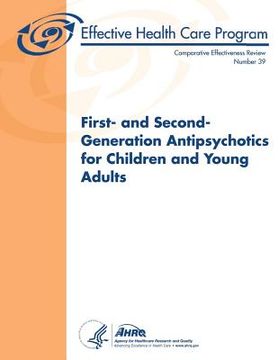First- and Second-Generation Antipsychotics for Children and Young Adults: Comparative Effectiveness Review Number 39 (en Inglés)
Reseña del libro "First- and Second-Generation Antipsychotics for Children and Young Adults: Comparative Effectiveness Review Number 39 (en Inglés)"
Antipsychotic medications are widely used to treat several psychiatric disorders and are commonly categorized into two classes. First-generation antipsychotics (FGAs), also known as typical antipsychotics, were developed in the 1950s. Although they are used to treat psychotic symptoms, they are associated with various side effects including extrapyramidal symptoms, which are movement disorders characterized by repetitive, involuntary muscle movements, restlessness, or an inability to initiate movement. Other common side effects are dry mouth and sedation. Neuroleptic malignant syndrome and tardive dyskinesia are rare but serious side effects. Second-generation antipsychotics (SGAs), also known as atypical antipsychotics, emerged in the 1980s. They are generally thought to have a lower risk of motor side effects. However, SGAs are associated with a higher risk of weight gain, elevated lipid and prolactin levels, and development of type 2 diabetes. Use of antipsychotics for children and adolescents has increased during the past 20 years. Prescribing antipsychotics to the pediatric population is controversial because there are few high quality and longitudinal studies on which to base clinical practice recommendations. For the majority of antipsychotic drugs, approved indications in the U.S. are restricted to the treatment of childhood schizophrenia and bipolar disorders. In 2006, the U.S. Food and Drug Administration (FDA) approved risperidone and aripiprazole for the treatment of irritability associated with autism. Off-label prescriptions are given to younger children for behavioral symptoms that are related to diagnosable conditions. In general, the choice of medication in children and adolescents is often driven by side-effect profiles that may affect growth and development, medication adherence and persistence, as well as other important domains such as school performance and health-related quality of life. This review provides a comprehensive synthesis of the evidence examining the benefits and harms associated with the use of FDA-approved FGAs and SGAs in children, adolescents, and young adults less than or equal to 24 years of age. The Key Questions are as follows: 1. What is the comparative efficacy or effectiveness of FGAs and SGAs for treating disorder- or illness-specific and nonspecific symptoms in children, youth, and young adults for the following disorders or illnesses? Pervasive developmental disorders, including autistic disorder, Rett's disorder, childhood disintegrative disorder, Asperger's disorder, and pervasive developmental disorder not otherwise specified; ADHD and disruptive behavior disorders, including conduct disorder, oppositional defiant disorder, and disruptive behavior disorder not otherwise specified; Pediatric bipolar disorder, including manic or depressive phases, rapid cycling, and mixed states; Schizophrenia and schizophrenia-related psychoses, including schizoaffective disorder and drug-induced psychosis; Obsessive-compulsive disorder; Post-traumatic stress disorder; Anorexia nervosa; Tourette syndrome; Behavioral issues, including aggression, agitation, anxiety, behavioral dyscontrol, irritability, mood lability, self-injurious behaviors, and sleep disorders. 2. Do FGAs and SGAs differ in medication-associated adverse events when used in children, youth, and young adults? 3. Do FGAs and SGAs differ in other short- and long-term outcomes when used in children, youth, and young adults? 4. Do the effectiveness and risks of FGAs and SGAs vary in differing subpopulations including: Sex? Age group (less than 6 years [preschool], 6-12 years [preadolescent], 13-18 years [adolescent], 19-24 years [young adult])? Race? Comorbidities, including substance abuse and ADHD? Cotreatment versus monotherapy? First-episode psychosis versus treatment in context of history of prior episodes (related to schizophrenia)? Duration of illness? Treatment naïve versus history of previous antipsychotics use?

